Select Language

NEW YORK (Reuters) - Futures traders have reduced bets on how much the Federal Reserve will cut rates this year to the lowest level since October, LSEG data showed on Monday, amid evidence of continued strength in the U.S. economy.
Fed funds futures contracts for December on Monday reflected expectations of around 60 basis points in rate cuts this year, compared to some 150 basis points that had been priced at the start of 2024. The prospect of a first 25 basis point cut in June stood at 49%, down from 57% a week ago, CME Group (NASDAQ:CME) data showed on Monday.
Expectations for how deeply and how soon the Fed will cut rates have shifted rapidly over the last few months, as investors grow increasingly doubtful that policymakers will be able to lower borrowing costs without sparking an inflationary rebound in a strong economy. The Fed has projected it will cut rates by 75 basis points this year.
Treasury yields, which are swayed by interest rate expectations, have moved higher as a result. The benchmark 10-year yield, which moves inversely to bond prices, hit its highest level since November on Monday. Data on Friday showed unexpected strength in the labor market, the latest in a series of reports reflecting stronger-than-expected growth.
In January, policymakers introduced language saying they would keep the policy rate in its current 5.25%-5.5% range until they have "greater confidence" that inflation is headed to the Fed's 2% goal.
The combination of strong data and limited progress on inflation in the last couple of months has amplified the calls among top officials - including Chair Jerome Powell - to be "patient" as they approach the decision on when to cut rates.
Investors will be closely watching the Consumer Price Index for March, which will be released on Wednesday, to further assess the chances of rate cuts this year.
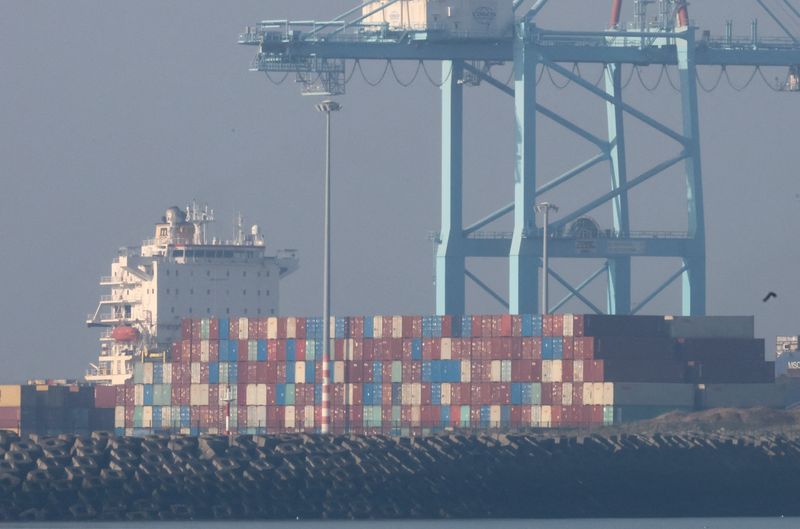
By Maria Martinez
(Reuters) - German exports fell more than expected in February, as exports to European Union countries dropped, data from the Federal Statistics Office showed on Monday.
Exports declined by 2% month-on-month in February and were lower than the forecast for a 0.5% decrease in a Reuters poll.
Imports were up 3.2% on the month, the statistics office said.
The foreign trade balance showed a surplus of 21.4 billion euros ($23.17 billion) in February, down from 27.6 billion euros in January and 16.9 billion euros in February 2023.
Exports to EU countries dropped by 3.9% on the month, while exports to third countries increased by 0.4%.
Exports of goods to the United States were up 10.2% compared with January, while exports to China decreased by 0.6% on the month.
"German trade is experiencing shifts in global trade and geopolitical tensions," said Carsten Brzeski, global head of macro at ING.
($1 = 0.9234 euros)

Investing.com -- U.S. inflation data will be in sharp focus in the coming week after Friday’s blowout jobs report raised the prospect that the Federal Reserve may delay interest rate cuts for longer. Big banks kick off earnings season, the European Central Bank is to meet and geopolitical risks look set to continue to support oil prices. Here’s what you need to know to start your week.
U.S. inflation data
The U.S. is to release consumer price inflation figures for March on Wednesday with economists expecting core inflation, which strips out food and fuel costs, to slow to 3.7% year-over-year from 3.8% the prior month.
Data on producer prices on Thursday is expected to point to a more moderate increase.
The inflation data comes after numbers out on Friday showed the U.S. economy added far more jobs than expected last month while wages rose at a steady rate, indicating that the pace of inflation may be slow to moderate.
The combination of strong employment data and slow progress on inflation in the last couple of months has amplified the calls among top Fed officials - including Chair Jerome Powell - to be "patient" as they approach the decision on when to cut rates.
Fed minutes, speakers
The Fed is to release the minutes of its March meeting on Wednesday where officials continued to expect three cuts for this year albeit with less conviction relative to their forecast from the end of last year.
In the wake of Friday’s jobs data money markets are now pricing in two rate cuts this year, down from three previously.
Market watchers will also get the chance to hear from New York Fed President John Williams on Thursday.
On Friday Fed Governor Michelle Bowman downplayed any urgency to cutting rates and warned that should progress on inflation stall that might even push the central bank to raise rates again.
Earnings
Quarterly reports from major banks will kick off earnings season in earnest on Friday.
Investors are counting on robust corporate profit this year to support rising valuations as the stock market has rallied to record highs.
The S&P 500 is up more than 9% year-to-date, following its strongest first-quarter performance since 2019. But the bar may be rising for stocks to keep advancing at that pace, increasing pressure on companies to deliver strong results.
Investors will also listen for companies’ views on the economy and inflation.
JPMorgan Chase (NYSE:JPM), Citigroup Inc (NYSE:C) and Wells Fargo (NYSE:WFC) all report results on Friday. Delta Air Lines (NYSE:DAL) and BlackRock (NYSE:BLK) are among other big names set to provide quarterly updates during the week.
Oil prices
Oil prices notched up a second weekly gain last week, supported by geopolitical tensions in the Middle East, concerns over tightening supply and expectations about demand growth.
Crude oil settled at its highest levels since October on Friday. U.S. crude futures rose 32 cents to $86.91 a barrel, while Brent settled up 52 cents at $91.17 a barrel.
Geopolitical tensions look set to continue to underpin oil prices as markets watch for any signs of any direct conflict between Iran, the third-largest OPEC producer, and Israel that could further tighten supplies.
"If Iran directly attacks Israel, that's never happened before," Phil Flynn, an analyst at Price Futures Group told Reuters. "It's just another geopolitical risk domino about to fall."
ECB meeting
The ECB meets on Thursday and is widely expected to hold rates steady before it embarks on a rate cutting cycle in June.
Markets see an almost 100% chance of a 25 basis-point cut in June so President Christine Lagarde’s comments will be closely watched for a green light.
A flurry of policymakers have explicitly pointed to June as the date of a first move and the latest data showed that Eurozone unexpectedly fell to 2.4% in March cementing expectations for a rate cut.
Apart from the ECB central bankers in Canada and New Zealand meet on Wednesday and in Singapore and South Korea on Friday with no rate changes expected.
(Reuters contributed reporting)
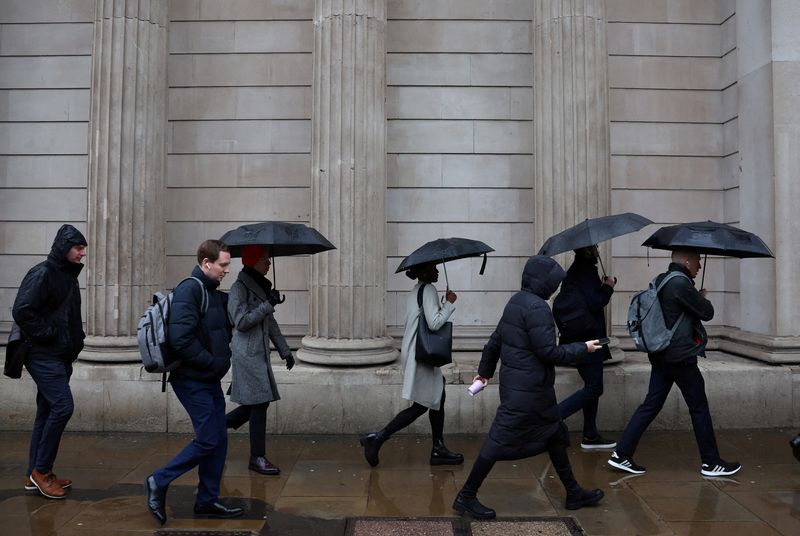
By David Milliken
LONDON (Reuters) - Starting salaries for permanent staff grew at the slowest rate in over three years last month and spending on temporary workers fell by the most since July 2020, recruiters said on Monday, adding to signs of a slowdown in Britain's job market.
March's survey from the Recruitment and Employment Confederation may help convince Bank of England policymakers that underlying pay pressures in the economy are easing sufficiently to keep inflation at its 2% target.
Official measures of pay growth have been rising at an annual rate of around 6%, roughly double the pace most BoE officials think is consistent with on-target inflation.
"The data here should support a decision by the Bank of England's Monetary Policy Committee to loosen its grip on growth in the near-term future. Pay growth has slowed significantly, and is now below the survey's long-term average for new permanent roles," REC Chief Executive Neil Carberry said.
However, the BoE has been reluctant to put too much weight on REC data in recent months, as the trends it has shown in the recruitment market have been slow to translate into lower wage growth for the broader workforce.
Last week a BoE survey of employers showed firms expected to raise pay by 4.9% over the next 12 months.
Financial markets predict the BoE will start cutting rates in June or August, with nearly 0.75 percentage points of cuts priced in for 2024.
REC said overall demand for staff fell for a fifth month in a row in March, and by almost as much as in February, when demand dropped by the most in more than three years.
Downward pressure on pay was caused by a greater supply of candidates, partly because of increased redundancies, it added.
REC's data is based on a survey of around 400 recruitment agencies between March 12 and March 22.

By David Milliken
LONDON (Reuters) - Concern among large British companies about economic uncertainty has fallen to its lowest since mid-2021 but the improved mood is not yet translating into stronger investment, a Deloitte survey showed on Monday.
Britain's economy entered a shallow recession in the second half of last year although recently published surveys have suggested there will be a modest return to growth in the first quarter of 2024.
"Uncertainties driven by Brexit, the pandemic and inflation that have clouded the business scene for much of the last eight years seem to be clearing," Deloitte chief economist Ian Stewart said.
Profit margins were forecast to rise for the first time in three years and overall optimism increased for a third quarter in a row to levels similar to those just before periods of relatively strong growth in 2010, 2014 and 2021.
Despite this, businesses were more focused on reducing costs and building up cash reserves than longer-term investment.
"Expansionary strategies, such as capital spending and bringing in new products or services, are on the backburner. Given the challenges of recent years it is perhaps unsurprising that ... a degree of caution persists," Stewart said.
Geopolitics remained the biggest worry of large companies, due to fears of increased cyber attacks or higher energy prices and a general fall in demand.
Concern about British productivity and competitiveness rose to second spot - the highest in a decade - displacing disquiet about inflation, energy prices and labour shortages.
Executives expected inflation in a year's time to fall to 2.9%, down from a prediction of 3.5% three months ago, allowing the Bank of England to cut interest rates to 4.25% from 5.25% over the next 12 months
The survey is based on responses between March 12 and March 25 from chief financial officers at 64 large British companies and subsidiaries of multinationals. The British companies have a market capitalisation of 200 billion pounds ($252 billion), equivalent to 8% of the stock market.
($1 = 0.7946 pounds)
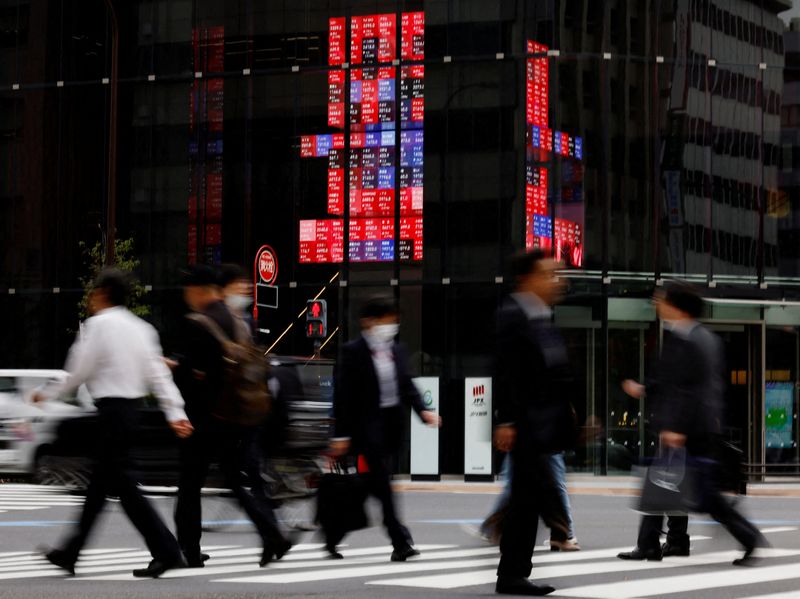
TOKYO (Reuters) - Japanese workers' real wages fell in February for a 23rd consecutive month, data showed on Monday, suggesting higher prices kept up pressure on consumers' spending appetite.
The wage trend is among the key data the Bank of Japan examines for pay and inflation outlooks, crucial factors for the central bank to consider in deciding whether to unwind its stimulus policy further.
Inflation-adjusted real wages, a barometer of consumer purchasing power, fell 1.3% in February from a year earlier, down for 23 straight months, data from the labour ministry showed. It followed a revised decline of 1.1% in January.
The consumer inflation rate the government uses to calculate real wages, which includes fresh food prices but excludes rent or equivalent, grew 3.3%, accelerating from 2.5% in January.
But nominal pay grew at 1.8% in February on the year, for its fastest increase since last June.
"We will monitor how growth in nominal pay will develop while price gains are weighing down real wages," a ministry official said.
Japanese firms agreed to raise wages 5.24% this year, the biggest increase in 33 years, a survey by the nation's largest union group Rengo showed last week.
Regular or base salary in February grew 2.2% from a year earlier, faster than a revised figure in the previous month, the ministry said.
Special payments, which include bonuses, slipped 5.5% year-on-year after a revised 12.4% gain in January.
Last month the BOJ scrapped eight years of negative interest rates and other remnants of its unorthodox policy, in a historic shift away from its focus on reflating growth with decades of massive monetary stimulus.
Here is preliminary data for monthly incomes and number of workers in February: ----------------------------------------------------------------
Payments (amount) (yr/yr % change)
-Total cash earnings 282,265 yen ($1,865.84) +1.8
-Monthly wage 277,479 yen +2.0
-Regular pay 258,319 yen +2.2
-Overtime pay 19,160 yen -1.0
-Special payments 4,786 yen -5.5
----------------------------------------------------------------
Number of workers (million) (yr/yr % change)
Overall 50.236 +1.3
-General employees 34.821 +3.5
-Part-time employees 15.415 -3.6
----------------------------------------------------------------
The labour ministry defines "workers" as 1) those employed for more than one month at a company that employs more than five people, or 2) those employed on a daily basis or had less than a one-month contract but had worked more than 18 days during the two months before the survey was conducted, at a company that employs more than five people.
To view the full tables, see the labour ministry's website at:
($1=151.2800 yen)
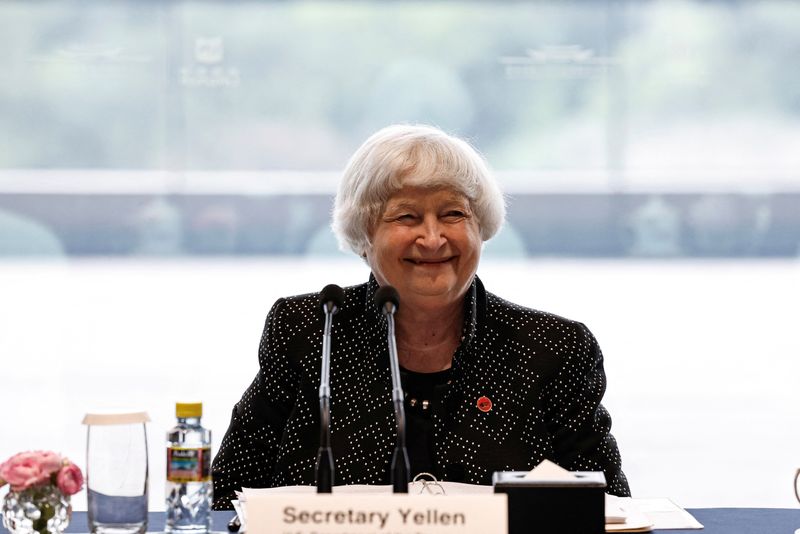
GUANGZHOU (Reuters) - U.S. Treasury Secretary Janet Yellen said on Friday that the United States and China have worked on an exercise for jointly dealing with a large bank failure in either country.
"We've held technical exchanges between our sides, including an exercise on how we would jointly deal with the failure of a large bank in the U.S. or in China," Yellen said in a question and answer session at an American Chamber of Commerce event in the city of Guangzhou.
Yellen made the comment about the joint work between the two sides to model financial risks from a potential bank failure as an example of the recent cooperative work between the two countries.
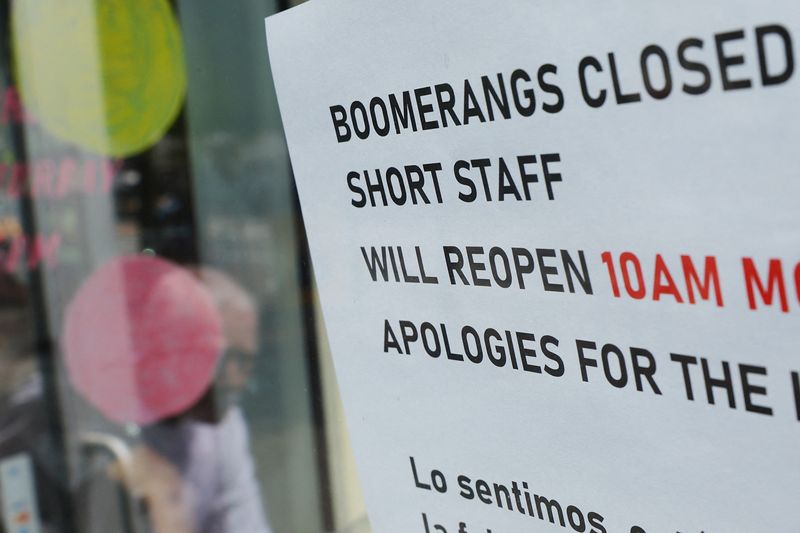
By Dan Burns
(Reuters) -Hiring plans among U.S. small businesses in March were the weakest since May 2020 when pandemic shutdowns threw the economy into recession, dropping below a key threshold some economists see as a bellwether for the wider job market, a survey out on Thursday showed.
A net 11% of firms surveyed by the National Federation of Independent Business last month said they plan to create new jobs in the next three months, down from 12% in February. With the decline, the index is now below its historic average of 11.8%.
"Job creation plans are now below what would be typical in a strong growth economy," NFIB said in its report.
The NFIB report comes a day before the monthly payrolls report from the Bureau of Labor Statistics, which is expected to show 200,000 new jobs were created in March, down from the 275,000 initially reported for February and the lowest total since November.
Job growth has slowed over the last two years, averaging nearly 230,000 a month over the 12 months through February, which is down from about 350,000 a month in the year through February 2023.
The slowdown comes in the face of stiff interest rate hikes by the U.S. Federal Reserve aimed at containing inflation, but job growth nonetheless has defied expectations for it to weaken much more than it has. The monthly growth rate is still well above the 190,000 a month average over the five years prior to the pandemic.
Still, with the Fed so far reluctant to begin reversing course and start lowering interest rates, economists are on heightened watch for any indication of developing weakness in hiring, and the NFIB report is one that bears watching, they say, as it shows a reliable correlation with the BLS data with a lag of several months.
While the outlook for hiring has dimmed, current hiring has held up, with 56% of firms saying they were hiring or trying to hire workers last month, unchanged from February.
"For now, employment activity remains solid, although waning from peak levels," the report said.
The NFIB report, like a separate report from payrolls processor ADP published on Wednesday, showed firms facing greater wage pressures last month. A net 38% in last month's NFIB survey reported raising compensation, up 3 points from February, which had been the lowest reading since May 2021. A net 21% plan to raise compensation in the next three months, up 2 points from February.

By Kevin Buckland
TOKYO (Reuters) - Japan's Nikkei share average tumbled more than 2% to a three-week low on Friday, putting it on course for its worst week since December 2022 as tech shares slid on Wall Street's lead.
Investors were also cautious ahead of a key monthly U.S. jobs report due later in the day, with the outlook for when the Federal Reserve will cut interest rates becoming increasingly unclear this week.
The Nikkei was down 2.42%, or 961 points, at 38,812.24, as of the midday recess, bringing its loss for the week to 3.86%.
"The biggest factor for the Nikkei's decline is technical," said Kazuo Kamitani, an equities strategist at Nomura Securities.
The benchmark index was poised for a second weekly loss, after it rallied to an all-time high of 41,087.75 on March 22.
The 25-day moving average turned lower on Friday, and should it remain that way, "there's the risk that the Nikkei is in for another step down from here," he said.
"The 25-day moving average has a mysterious gravitational pull, and is very much in focus for the market," Kamitani added. "All of next week, stock market moves could be a bit volatile."
Chip sector shares were among the biggest drags on Friday, with Tokyo Electron dropping nearly 5% to shave 192 points from the Nikkei. Advantest erased another 78 points with a 4.7% decline.
Other notable losers included startup investor SoftBank (TYO:9984) Group, which lost 3.35%, and Uniqlo chain operator Fast Retailing, which skidded 2.5%.
Of the Nikkei's 225 components, 214 declined while only 11 advanced.
The broader Topix lost 1.81%, with a sub-index of growth shares dropping 2.05%, compared with a 1.6% slide for value stocks.
Energy shares provided the one bright spot among Nikkei sectors, climbing 0.73% after crude oil closed above $90 for the first time since last October. [O/R]
Oil refiner Inpex was the Nikkei's biggest percentage gainer with a 1.3% jump.

TOKYO (Reuters) - Japanese household spending fell 0.5% in February from a year earlier, down for a 12th straight month but better than the median market forecast for a 3.0% decline, government data showed on Friday.
When adjusted for the leap year effect of having one more calendar day on Feb. 29 compared to regular years, household spending fell 2.7% in February year-on-year, according to the government's estimate of the data.
On a seasonally adjusted, month-on-month basis, spending increased 1.4%, also better than an estimated 0.5% gain.

